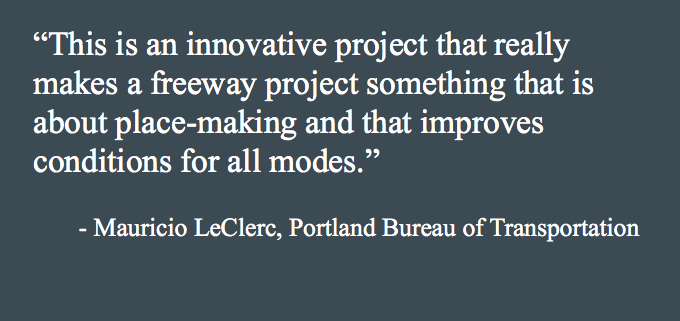“We would love to see this project successfully set a new precedent for how we address urban highways in Portland.”
— The Street Trust (formerly the Bicycle Transportation Alliance)
Technically speaking, not all freeway projects are created equal. But they all pretty much have the same goal: Make it easier for people to drive cars.
That being said, is it ever a good idea to widen a freeway in a dense, urban area? In 2017?
From an engineering perspective, the Oregon Department of Transportation’s current plan to add lanes to Interstate 5 at the Rose Quarter is a far cry from the 1950s-era plan to build the Mt. Hood Freeway through southeast Portland or the more recently vanquished Columbia River Crossing project.
A major theme of the current debate is whether the I-5 Rose Quarter project is qualitatively different. What if — as its backers (and fence-sitters) say — it represents a new era of highway building? One that’s kinder and gentler? One that even (supposedly) progressive Portlanders should get behind? What if this one is worth it and the “No More Freeways” mantra from activists is a knee-jerk reaction to an old boogeyman that deserves a chance to make good?
These are just some of the many question I want to address in the coming days.
The debate around this project is heating up as we’re just about one week away from a Portland City Council hearing that a new coalition group has targeted as the place to stop it.
While this coalition sees the project as a waste of money that will encourage auto use (among other things) — people who support it see it as a golden opportunity to fix local streets and bridges in the Lloyd District that serve thousands of daily bikers and walkers. Some even push back at the notion that it’s a “freeway widening” project at all.
Back in March, Portland Bureau of Transportation Planner Mauricio LeClerc told the Portland Planning and Sustainability Commission that, “This is an innovative project that really makes a freeway project something that is about place-making and that improves conditions for all modes.” LeClerc also warned that if the project doesn’t go forward, funding for surface street updates and new overpasses would improve convenience and safety for bicycle users could be lost. “How else are we going to fix those five bridges over the Rose Quarter now, unless we come up w $200 million ourselves?”
Advertisement
BikePortland commenter Beeblebrox (a regular commenter who I can verify is well-informed on the issues) has said, “It should be noted that the project does not actually “widen” I-5… [what it does is] connect the I-405 on-ramp to the I-84 offramp without a merge required, and vice versa in the other direction.” Furthermore, Beeblebrox justified the project yesterday by saying, “The fact we’re getting handed state money that otherwise would go to a true freeway widening project, and instead it’s going to a small operational improvement and a ton of surface improvements should be celebrated, not opposed. This really is a model for how urban freeway projects should be.”
Even The Street Trust (formerly the Bicycle Transportation Alliance) is giving this project plenty of breathing room. Even though they, “Agree with many of the concerns raised by opponents of the project,” they don’t oppose the project. The Street Trust has decided to not sign the No More Freeways coalition letter to City Council. In a blog post today, the group said, “To remain consistent with the compromises reached with legislators and stakeholders in the bill, we have chosen not to sign on to this coalition’s letter.” And echoing PBOT and Beeblebrox’s optimism, The Street Trust says, “We would love to see this project successfully set a new precedent for how we address urban highways in Portland.”
It feels like we’re putting a lot of trust into ODOT. Should we?
Faced with massive opposition from Portlanders and the City of Portland (my how times have changed) to their Mt. Hood Freeway plan in the 1970s, ODOT tried adding other elements to make the project more palatable. “Among the proposals were increased landscaping and bike paths along the route as well as parks and community centers built over the freeway’s ‘air rights’ and a ‘transitway’,” reads the Wikipedia entry. “These efforts, however, were not enough to sell the project.”
And we know what happened with the CRC: All ODOT wanted to talk about was “the bridge” and plans for a bike path and light rail that would connect Portland and Vancouver. ODOT made enough promises that major environmental and transportation nonprofit groups — including The Street Trust, Oregon Environmental Council, Oregon League of Conservation Voters, and others — didn’t fight it (or in the case of the The Street Trust, only fought it after enabling it for years with their involvement on advisory committees). This was despite the reality that the CRC was a massive freeway project that would have built huge on and off-ramps for miles in both directions at great cost to our region’s finances and health.
And here we are with I-5 at the Rose Quarter: It’s either going to be a “precedent” setting, “innovative” and “place-making” project that sets a new standard for urban freeway project — or it’s just an example of how much better ODOT has gotten at green-washing, bike-washing, and safety-washing yet another massive investment in automobile-oriented infrastructure.
Stay tuned for more coverage. We value your input. Thank you.
===
(NOTE: We will address more issues with this project in the coming days including the role of congestion pricing, what we know about the project details, the financing, and so on.
— Jonathan Maus: (503) 706-8804, @jonathan_maus on Twitter and jonathan@bikeportland.org
Never miss a story. Sign-up for the daily BP Headlines email.
BikePortland needs your support.


